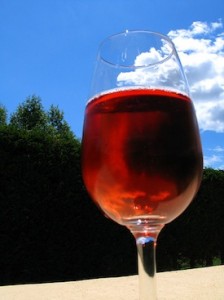Rose’ Season 2012 has arrived

Rose’ season is in full swing, and we have incredible selections from around the world at The Wine Company. Sales of dry rose’ wines continue their upward path, and this is a good time to review how rose’ is made as well as some ideas on how to sell it.
Making rose’ by blending
Simply adding some red wine to white wine is not a common practice, and is discouraged in all major wine regions (the one great exception being Champagne, of course). This has, in the past, been the way some very cheap pink wines have been made, but the resulting wines have little to do with what we are talking about here.
Making rose’ by skin contact
Because the color of a red wine comes from the skins of the grapes, if you take red or black grapes and press them gently, then leave the skins in contact with the juice for a small period of time (usually 2-4 days will do it), you only get a hint of the color rather the dark richness of ‘normal’ wine. This method is used when the entire production of a batch of grapes will be for rose’ and rose’ alone, as in Tavel, France.
Making of rose’ by saignee (“SAHN-yay”, French for ‘bleeding’)
The third method of production is the ‘bleeding’ of a tank. When a red wine is being made, the initial crush of the grapes in the tank are released by opening a valve at the bottom. This first free-run juice that comes out has only a slight hint of color and is sent to another tank for a separate fermentation. After 10-15% of this first juice is captured, the valve is closed and the production continues as normal. Thus, a winemaker ends up with a more concentrated and deep red wine, and at the same time a beautiful pink wine that you can enjoy during the upcoming summer season. This method has been used in all major wine regions for decades – pink wine as a natural by-product of good red wine production.
***
For retailers and restaurants: HOW TO SUCCESSFULLY SELL ROSE’
RETAIL: You group them all together, front and center, with a sign announcing “Dry Rose’ season has arrived!” This achieves a few things: 1) it keeps the wines in one spot, rather than dispersed around. The visual impact is amazing. 2) It encourages questions from the customer, and anytime a customer asks a question you have an opportunity. 3) It emphasizes the word DRY because some people still associate pink with sweet. Point out to them the alcohol content (whenever a wine is over 12% alcohol you are pretty assured of holding a dry wine).
RESTAURANTS: Some of the same techniques apply. Put the bottles out where customers can see them. Have servers walk around with them. Give free taster samples. Have a rose’ season kick off party. Emphasize that if you are in Provence or Paris in the summertime, this is what you drink. Present some of the classic Mediterranean style summertime dishes and have them come with a free half glass of rose’ (just build the price of the wine into the dish). If you want to be in the top one percent, have a rotating rose’ flight — no need to print a wine menu for it (the server can pour and show the bottles at the table) … three half glasses of great pink wine at a set price. You can then rotate through a huge number of selections for the summer season.
Photo of a delicious glass of rose’ by Flickr user Gak







